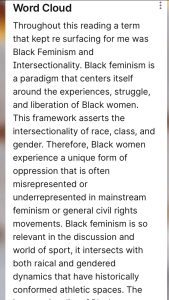1
Section One: The Fundamentals
A) What do we know about sport? What are common assumptions we make about sport and society?
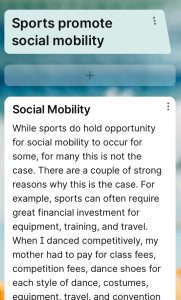 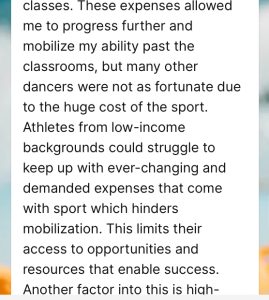 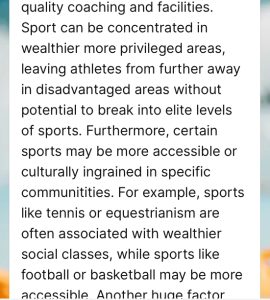 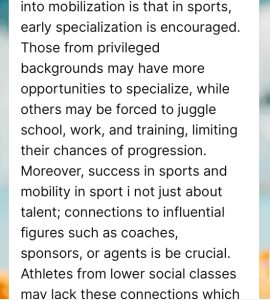   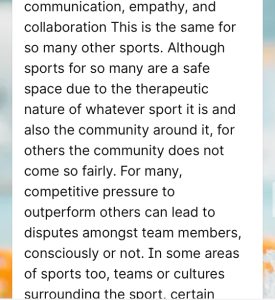 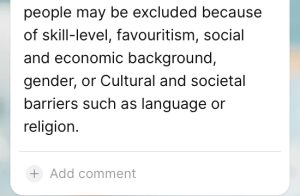 |
Exercise 3: Notebook prompt
What are some other metanarratives about sport that you are familiar with? Find an image or video clip or draw something yourself that captures this idea…
So what? Why does any of this matter? Does it matter? As something we grow up with – live with – play through – we don’t often interrogate the meanings of sport, and perhaps we don’t want to.
But being aware of these assumptions and metanarratives is especially important, I would argue, because of the centrality of sport to our everyday lives, the role that sport plays in shaping our childhood and worldviews and….. [finish that thought]
| Other Meta narratives about sports could include the Rags to Riches trope. This involves “humble beginnings” for an athlete who rises to success. This promotes the ideal of social mobility and indicates that it is obtained through talent and hard work. This celebrates the idea of overcoming something through sheer, humble, dedication. Critically reflecting on this notion, however, we can see that this ideology oversimplifies systemic inequality and the very limited opportunities available to individuals in specific socio-economic statuses. This narrative becomes problematic and flawed as it fails to acknowledge the potential limitations in accessing resources, networks, and the luck that contributes to success. Moreover, it runs the risk of idealizing and romanticizing poverty as well as framing mobility as an individual effort rather than a structural one. It suggests that anyone, regardless of their status, health, background, can achieve ‘greatness’ no matter their situation as long as they, “Just work hard enough”. This obviously downplays the role of racism, classism, gender discrimination, and lack of access to quality education or training.
Why?: Focus on individual triumph and the notion of “anyone can make it” distracts from larger barriers/ When we uphold this ideal/metanarative we set an unrealistic standard for achievement. When individuals do not meet this unrealistic standard, it can become mentally and physically discouraging/damaging.
|
B) What is social justice?
Exercise 4: Padlet Prompt
Think back to the last section and try to look at some of the ideas we discussed differently. How might sport and social justice actually co-exist?
Record any images, video clips, or gifs you added to the padlet and identify a point of intersection between sport and social justice (can be an issue or a barrier or a debate or something you would like to explore in more depth in this course) . Screenshot or paste in your response below.
| Access and Opportunity;
Sports and social justice can co exist through access and opportunity. Sports provide a space to create opportunities for individuals from diverse backgrounds. For example, the club I work for is called BGC Kawarthas and we provide low-income sports opportunities for children ages 4-12. By ensuring equal access to resources, facilities, and programs, social justice can hep bridge any gaps for historically marginalized communities to be able to play. Initiatives like scholarship programs, grassroots sports development, and accessible sport leagues are practical ways to promote equity for all in sports.
Equity and Representation: Sports can act as mirrors for society. They reveal the disparities in representation and identify the need for equity. By ensuring all people of any race, gender, ability, or socio-economic backgrounds have a voice in sports, organizations can work toward more inclusive representation within their overall community. This helps combat systemic barriers and develops a space where all individuals are equally valued. Advocacy and Activism: I think that athletes and organizations have for a long time used sport as a platform for social justice. From Muhammad Ali’s stand against the Vietnam War to Colin Kapernick’s kneeling protest against racial injustice and violence, sports can be megaphones for social causes. Additionally, athletes are looked up to, desired, and promoted, so when their beliefs and values are rooted in social justice, sport and social justice go hand-in-hand. Through peaceful protests, community involvement, and public statements, athletes can advocate for visibility and political change.
Community Engagement: Sports often bring individuals together and develop a sense of community and trust. In using sport as a promotion tool for unity, understanding, empathy, and social cohesion, sports support communities facing division and inequality. Sports programs focused on building relationships between diverse groups can alleviate stereotypes and prejudice. An example of this type of social justice in sports is the Midnight Basketball league. This league was popularized in the 80s and aimed to engage youth in disadvantaged communities by offering a structured, positive alternative to crime late at night. Basketball games were played after midnight as a way to promote safe and productive environments.
|
C) Social Justice Reading
(note: this activity is optional!)
D) KINESIOLOGY AND SOCIAL JUSTICE
Exercise 5:
Exercise 6:
What are the implications of bodies-at-risk discourse and the refusal to understand the health gap from a social justice perspective, according to the authors of this article?
| The bodies at risk discourse is the framing of individuals or groups as being susceptible to harm due to factors such as health risks, environmental dangers, and societal conditions. It emphasizes bodily vulnerability and a need to protect individuals from these risks, framing certain bodies as more exposed or at risk than others. However, many sociologists and social justice activists such as the authors of this modules reading, Harrison et al, believe that this discourse frames vulnerable peoples or groups, like women, ethnic-minority groups, and people in poverty, as inherently deficient and as an issue that needs solving rather than addressing the root of the problem – the broad structural conditions that contribute daily to their vulnerability. The authors argue that when an oversimplified understanding of health is adopted and health disparities are not viewed through a social justice lens, the focus of health shifts to biological and purely medical explanations/understandings of health, ignorantly turning a blind eye to various social determinants of health such as poverty and education. So, while the bodies at risk discourse does highlight key vulnerabilities, it narrows conversations about health risks to individual factors, making them seem like an individual responsibility, rather than emphasizing the societal, political, and economic elements that add to their vulnerability. In the context of gender, sports, and social justice, the bodies at risk discourse refers to the way bodies of athletes, particularly women, are viewed as vulnerable to physical, emotional, and psychological harm due to their participation in sports. This discourse emphasizes fragility, weakness, even reproductive vulnerabilities, even when there is little scientific evidence to support these fears. This ideology promotes fierceness, resilience, and strength for men and immediately pushes women’s capabilities further to the background. |
Section Two: Sport Feminism
Exercise 7: Notebook Prompt
What is feminism? What does it mean to you? Choose one of the images below and explain how it captures your understanding of feminism (or find one that does speak to you and paste this into your pressbook with an explanation of why it matters to you.
| Feminism to me is a very broad umbrella term, it categorizes a whole plethora of ideas, movements, and perspectives aimed at achieving gender equality. Each element of feminism is united at the core goal of dismantling gender-based oppression, discrimination, and the patriarchy. For my, my focus in feminism is intersectional. Feminism is such a broad social, political, and cultural movement that to me it should always advocate for the equal rights, opportunities, and access for any woman, while challenging societal norms, violence, and inequality. Regardless of gender, feminism is a fight for justice. I chose the picture of a guy in a shirt that says “this is what a feminist looks like” and the colour-grading over the image made it pink. To me, this is a powerful statement to challenging the stereotype of what feminism is. Most people automatically assume a feminist can only be female. People assume that the agenda is driven by “male-hating” women. However, this is so far from the truth. Feminism is not gender specific, it is about standing for equity regardless of who you are. Men can be- and should be – feminists too. Their participation in feminism is dire in the creation of inclusive, equitable, societies, free of hyper-masculinity and misogyny.
To conclude, feminism to me, in its many forms, is a diverse and ever-evolving pledge that hopes to improve social, political, and economic gender-based inequalities.
|
Exercise 8: Notes Prompt (optional)
NB: Cornell notes is a great resource that teaches effective notetaking. Unfortunately, our system can’t save notes taken in the H5P app, so this is fully optional.
Exercise 9: Crossword Activity
Exercise 10: Padlet Prompt
|
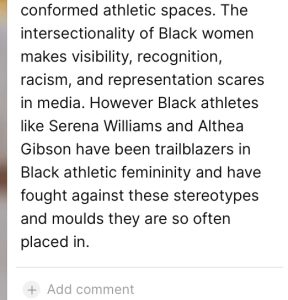
|
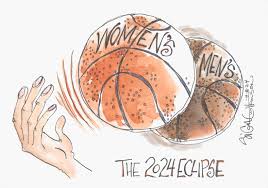
| Yes, I feel that the landscape is changing in regards to women’s sports. While challenges still remain, the momentum in female sports is growing rapidly. First, I think media coverage is now being engaged with far more and produced far better as well as more accessibly which makes this possible. I also see a shift happening in social media, where female athletes become powerful and admirable figures in fans lives. For example, one of my favourite shows is Dancing With The Stars. This past season, Female Olympic rugby player, Ilona Maher, made it to the finales and proved to be an incredible influence in so many little girls lives ( and big girls too!) She proved that women can be both muscular, fierce, strong, delicate, dainty, and all around beautiful in both rugby and dance. I also see a shift occurring in hockey, finally North America has created a Professional Women’s Hockey League (PWHL) which has seen incredible turn-out and positive feedback. So, in short, I do feel that people are now caring about women’s sport. However, the level of media exposure, societal attitudes, and investment does matter and will continue to matter in increasing engagement. While people are beginning to care about WATCHING women’s sports, they also need to care about how women’s sports are being payed as well. More engagement and fans increased the wages these professional women’s athletes are earning, creating a cycle of growth for women everywhere.
|

